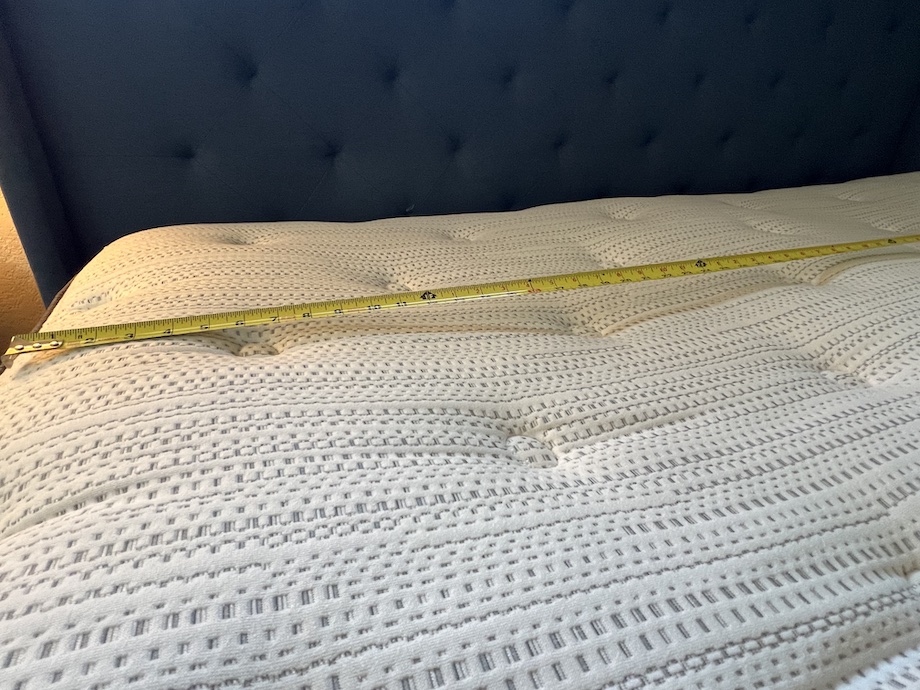Is your bed sinking in the middle? Over time, the part of the mattress you spend the most time on will naturally experience the most wear and tear. Even though sagging mattresses are all too common, they are no fun to sleep on, and doing so for an extended period may negatively impact your back.
Venice may be sinking, but that doesn’t mean your mattress has to. Read on as we discuss the best ways to fix a sagging mattress and help you decide whether it’s time to purchase a new one altogether.
Our How to Fix a Sagging Mattress Video Guide

How to Fix a Sagging Mattress
A sagging mattress is often a signal to shop for a new bed. However, you can use several tactics to extend the life of your aging mattress before shopping for a new one.
1. Flip and Rotate the Mattress
Moving your mattress around will change where your body is distributing your weight while sleeping. Rotating your mattress can reduce any sagging that’s already begun and provide you with a fresh, more comfortable area to sleep.
Get More Info: How Often Should You Flip Your Mattress and Best Flippable Mattress
2. Replace the Mattress Foundation
Just like your mattress, the foundation of your bed can deteriorate over time. A faulty foundation could be the cause of your mattress sagging in some cases. If your bed platform uses slats, confirm their even placement, with no significant gaps for your mattress to sink through.
Mattress foundations with only four legs may also begin to sag in the middle without center support. If your bed lacks an even foundation, the pliable materials will follow the uneven shape. Switching out the box spring or bed frame for your mattress can often solve sagging issues.
3. Use a Mattress Topper
One of the easiest ways to upgrade your bed and remedy your sleep once your mattress has started sagging is a mattress topper. Adding a topper gives your bed additional height and a new layer of comfort. Typical mattress toppers consist of foam or latex; you can also find filled, quilted mattress toppers stuffed with wool or down feathers.
The topper can add a significant cushion to your mattress and provide support where you need it most. While adding a mattress topper will not stop your bed from sagging, it could make your bed comfier in the meantime.
4. Add Extra Pillows
Another quick fix is to add more pillows to your bed. The pillows may fill in the sagging area and provide a more level surface. Pillows will not necessarily stop your mattress from sagging, but they might help you get a good night’s sleep. In addition, these pillows can help reduce pain in your legs, hips, back, and neck.
Be sure to only use pillows on the surface of your mattress. Placing the pillows between your mattress and the foundation can speed up the deterioration of your mattress.
5. File a Claim With Your Mattress Warranty
If none of these solutions sounds right for you, you also have the option of filing a claim with your mattress’s warranty before purchasing a new bed out-of-pocket. Be sure to read the terms of your warranty carefully.
If you can link the sagging in your mattress to a reason the warranty covers, the manufacturer may replace or fix your damaged mattress. Companies may send a person to your home to inspect the mattress.
Why Do Mattresses Sag?
You can find many different kinds of mattresses on the market, consisting of various materials. The components and structure of your mattress contribute to how long it will last before it begins to sag.
With repeated use every night, your body weight compacts and softens the materials of your mattress, creating an indentation in the most-used sleeping area of your bed. Furthermore, you’re most likely to feel the sag around your center of gravity. When your mattress no longer provides consistent support, your sleep quality may diminish, and you may start to experience back pain or have existing pain worsen from the lack of support.
How to Prevent a Mattress from Sagging
If your mattress is still reasonably new and in good shape, it is always easier to work on preventing sagging than to fix a bed that has already started to decline. You can also use several of the above tips to extend the life of your mattress before it starts causing you problems. Try implementing some of these strategies to maintain your mattress quality:
- Sleep in a different position.
- Regularly rotate your mattress.
- Ensure that you’re using a supportive foundation or box spring.
- Maintain the foundation of your mattress regularly.
- Add a mattress topper to your bed.
- Do not jump on the mattress
Signs You Need a New Mattress
While all these tips and tricks can certainly extend the life of your mattress, no mattress will last forever. Eventually, you’ll need to replace your mattress. How often you should replace your mattress comes down to the kind of mattress you have.
If any of the following apply to you and your bed, it might be time to go mattress shopping.

Poor Sleep Quality
If your sleep quality begins to deteriorate, it could be a sign that your mattress needs replacing, even if it’s not showing any noticeable signs of sagging. In this case, you should look into alternatives.
Neck or Back Pain
Sagging or aging mattresses could lead to neck and back pain. The reason for this is that when you do not receive proper support while you sleep, you put stress on your spine for hours each night. Over time, this stress can cause discomfort and pain.
Broken Mattress
Unfortunately, spotting the signs of a corrupted mattress is not always as apparent as a consistent indentation or damaged springs poking through the cushioning.
One of the most telling signs that your bed needs replacing is edge sagging. Beyond sinking where you sleep, if the defined edges of your mattress begin to fail, you are no longer resting on a safe surface. Poor edge support could lead to you falling out of bed.
If you are looking for a new mattress, take a look at our list of the Best Mattresses of 2024.
Most Durable Mattresses
If you need to replace your mattress, you want to ensure that your new one will last for close to a decade or more. Most mattresses last around seven to 10 years, but purchasing a high-quality mattress could extend that lifespan.
Latex mattresses are exceptionally durable, with some lasting as long as 15 years. Even though they have a higher upfront cost, the benefits can outweigh the higher price tag. Another advantage of these beds is that they’re often made with more sustainable materials, making them a more eco-friendly choice.
Hybrid mattresses combine mattress styles and materials, taking the best features from coil, foam, and latex beds to create maximum comfort. In addition, they come in various firmness and support levels, giving you many options to discover the right mattress for you.
Sagging Mattress FAQs
How long should a mattress last before sagging?
How long a mattress lasts depends mainly on its construction and quality as well as how you use it. For example, jumping on the bed will likely cause sagging much faster. Most high-quality mattresses have a lifespan of seven to 10 years, while low-quality beds might start sagging after only a few years.
Do Purple mattresses sag?
According to Purple, their mattresses are designed to last up to 10 years if used as intended. If your Purple mattress develops sags sooner and with normal use, you should contact the company before the warranty is up.
Do latex mattresses sag?
Though they’re often more durable, latex mattresses aren’t immune to sagging. For this reason, it’s often recommended to get a supportive base that ensures the mattress is supported all across. When properly supported, a high-quality latex mattress could last 15 years.
Do Saatva mattresses sag over time?
Saatva mattresses are high-quality and made to last at least seven to 10 years, according to the company. However, some people had different experiences, reporting their Saatva sagging after only a few months. In some cases, this might be due to an improper base with slats too thin or far apart, in which case the mattress isn’t properly supported. Saatva beds have a lifetime warranty, so you should contact the company if you think yours has a defect.

Julia Forbes
Sleep Advisor Mattress Tester
About Author
Julia is a product tester at Sleep Advisor, specializing in testing out mattresses and sleep accessories – she’s in the right line of work, because she loves to sleep.
Stomach Sleeper
Education & Credentials
- Certified Sleep Science Coach
